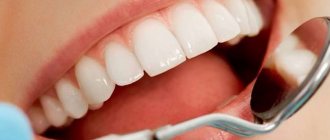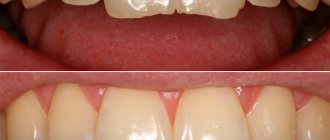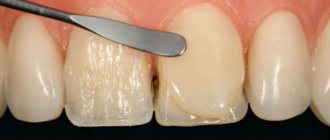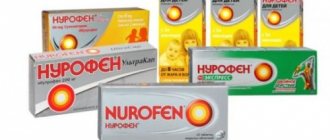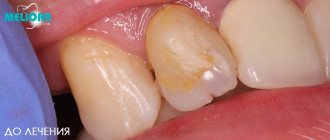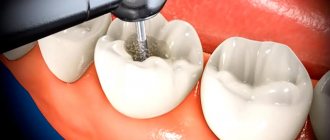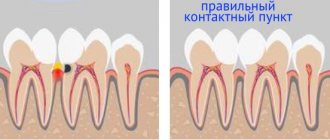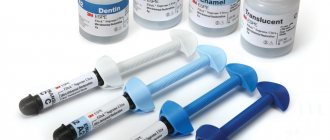Fillings made from a material such as a chemical composite mimic and replace natural tissue lost due to disease, subsequent treatment, or injury. Dentists use them to fill large cavities, including teeth with removed pulp. They are affordable and have excellent durability characteristics. Restoration using them will ensure full restoration of chewing function, and this despite the fact that it will serve for a long time!
Therapists at the CELT Dentistry Department widely use composite fillings to restore dental tissue. They have modern materials at their disposal, which, along with precise adherence to technology, make it possible to obtain beautiful, functional and durable restorations. Treatment is carried out on the basis of a contract with a guarantee. You can find out the cost of composite fillings in the price list by going to the “Services and prices” tab. Despite the fact that we regularly update it, we recommend that you check the numbers by contacting our information line operators or visiting a doctor.
Consultation with a dentist-therapist - 1,000 rubles.
Filling made of chemically cured composite—RUB 1,500.
At CELT you can get advice from a dental specialist.
- The cost of a consultation with a dentist-therapist is 1,000
Make an appointment
Types of fillings made of chemically cured composite
Chemical composite materials began to be used in dentistry in the 60s of the last century. Fillings made from it are called ordinary or cement. Their distinctive feature is that they crystallize due to a chemical reaction, which is launched during the process of mixing their components. They themselves are very durable, which can be called both an advantage and a disadvantage. The fact is that their hardness exceeds the hardness of dental tissues, which is why they wear out and the tooth itself is destroyed.
| Types of cement fillings | |
| View | Distinctive features |
| Composite | It includes several components, is characterized by uniform hardening, and lasts about twenty-four months. After hardening, its color may differ from the color of the enamel, so it is best to place it where it will not be visible (on the molar). |
| Glass ionomer | Manufacturing occurs by mixing an aqueous solution of polyacrylic acid and aluminofluorosilicate glass powder. The crystallization effect is achieved through an acid reaction. |
Kinds
All compomers are divided into three large groups - packable, medium creamy, liquid-flowing. The materials being packed are quite viscous; they are rubbed into the surface with a tool. The content of organic components is high, but the hardness is insufficient. Used only for those teeth where chewing loads are the lowest.
Medium-consistency ones have a cream-like composition. They are universal and are used to fill various types of cavities. They have good characteristics, strength, durability.
Liquid materials are recommended for use in situations where the use of packaging materials is severely limited. They are easy to apply, harden quickly, and have good characteristics.
Materials are also divided into fixing, restorative, and insulating mixtures. Special materials are produced for the treatment of temporary units, fissure filling, and others.
The materials include:
- acrylic resins that provide polishability, such indicators as viscosity, strength, resistance to mechanical loads;
- polymerization initiators (ethyl 4-dimethylaminobenzoate, camphorquinone);
- thickeners in the form of silicone dioxide;
- aluminum glass (strontium-aluminium-sodium-fluoro-phosphorosilicate glass);
- strontium fluoride, providing fluoride therapy, protective, preventive effects;
- iron oxide, titanium dioxide for coloring the mixture and giving the required, lasting shade.
Features and advantages of composite fillings
The price of fillings made from a chemical composite is low: they are among the cheapest available today. This is due to the fact that they are unable to provide a good cosmetic result. At the same time, it is not required when it comes to molars: a darker color will not be a problem, but the structure itself will withstand intense loads during chewing and will last for many years. It contains fluoride, which will prevent the development of caries and destruction of tooth enamel.
Due to its excellent strength characteristics, the average service life of a conventional filling ranges from ten to fifteen years. However, it only depends 60% on the material of manufacture: an important factor in this case is regular and correct oral hygiene measures. Advantages of composite fillings:
- good strength characteristics, hardness;
- long service life;
- low price with simple application;
- high speed of restoration production;
- uniform hardening, regardless of the size and depth of the cavity;
- immunity to the effects of saliva;
- minimal risk of cracking of the filling.
Chemically cured composites are “powder-liquid” or “paste-paste” systems. The rate of their hardening depends on the number of active elements, temperature and the presence of inhibitors. Indications for installing a filling on a tooth made of a chemically cured composite:
- the need to obtain a hard, wear-resistant, durable restoration;
- restoration of a unit with a deep carious cavity;
- restoration of posterior chewing units;
- the patient's request to use budget materials.
The basis of composites in dentistry
Composite materials in dentistry consist of three components:
- Organic matrix;
- Inorganic filler (at least half of the total mass);
- Silane (silicon hydride, connects the first and second components).
The matrix, or matrix, is the main component of the composite, its base. The quality of the product depends on the base: compatibility with the patient’s body, flexibility, strength of fixation. The matrix is responsible for maintaining the desired shade and volume. The basis is polymer resins, for example, bisphenol glycidyl methacrylate or urethane dimethyl methacrylate. The resin does not perform all functions on its own, but uses auxiliary substances:
- Polymerization inhibitors – extend service life;
- Catalysts – begin polymerization;
- Co-catalysts and photoinitiators – promote curing;
- UV absorbers - retain color.
Reviews about our dental therapists
Words cannot express my gratitude to Elena Nikolaevna Kiseleva.
This is the best doctor in the world. I got an appointment after many years of being ignored by the dentist’s office and with the bitter experience of treatment in another paid clinic, the mistakes of which had to be corrected in the first visits. Thank you for this... Read full review Roman Stanislavovich Sh
25.07.2020
I would like to thank the wonderful doctor Natalya Olegovna Elizarova for her high professionalism, sensitive and kind attitude, the doctor has golden hands! He is honestly dedicated to his work and a wonderful person who treats his patients with understanding. I wish you health and success!!! Thank you, ... Read full review
Larisa
15.01.2018
Requirements for composite materials in dentistry
In order for composite materials to be used in dentistry, they must meet the following requirements:
- X-ray visibility;
- Tight adhesion to the tooth;
- Impermeability;
- Strength;
- Ability to resist friction;
- Ease of use;
- Compatibility with tooth and mouth tissues;
- Long service life;
- Naturalness;
- Compliance with the physical properties of the tooth;
- Multifunctionality;
- Availability.
Composite as a dental material has gained popularity among dentists. This is explained by the listed advantages of composite filling materials. However, the ideal composition has not yet been found. Research in this area is ongoing.
Differences between a filling made from a chemically cured composite and a filling made from a light-cured composite
The “light” filling got its name from the curing method: it occurs under the influence of a UV-radiation polymerization lamp. Thanks to him, the dentist has the opportunity to give it a certain shape as accurately as possible. After hardening, the material adheres as tightly as possible to the native dental tissues, without differing from them in color. For this reason, such structures are most often used on frontal teeth. Their service life is about five years.
| Differences between regular and “light” fillings | ||
| Parameter | Regular | "Light" |
| Polymerization method | As a result of starting a chemical reaction when mixing components | Under the influence of light emitted by an ultraviolet lamp |
| Application area | Premolars and molars | Smile zone teeth |
| Comfort of treatment | Preparation is a cause of discomfort | Minimal preparation |
| Price | Available | Higher |
| Material toxicity | May release toxins | Non-toxic |
| Color | As it hardens, it becomes darker in color. | Possibility of selection in accordance with the color of the native enamel |
Qualities of composite filling materials
In order to choose the right composition, you need to know what qualities it has:
- Resistance to compression or tension. Can vary from 220 to 450 MPa, influenced by how heavily the material is filled.
- Resists wear. Depends on particle size.
- Color preservation.
- Visibility on X-ray. Can be 130–350%.
- The degree of shrinkage during hardening. Varies from 1.6 to 5.5%.
- Conversion of material density under the influence of mechanical load. Without external influence, the viscosity should increase.
- Thermal expansion. It is required to match the expansion natural to the tooth.
- Flexibility, the ability to change shape when compressed or stretched.
- Compatibility with the patient's body, taking into account international standards (ISO).
- Comfort when working, the ability to quickly complete a task with minimal effort.
- Appearance – the ability to choose the desired color, create a natural coating.
What determines the price of a chemical composite filling?
The cost of installation is calculated by the dentist after examination and diagnosis. It depends on:
- the degree of tooth decay and the need to use additional means (for example, linings for caries);
- area of location of the affected dental unit;
- pricing policy of the dental clinic and the level of qualification of the dentist.
You can make an appointment with CELT dentists online or by contacting our information line operators.
Make an appointment through the application or by calling +7 +7 We work every day:
- Monday—Friday: 8.00—20.00
- Saturday: 8.00–18.00
- Sunday is a day off
The nearest metro and MCC stations to the clinic:
- Highway of Enthusiasts or Perovo
- Partisan
- Enthusiast Highway
Driving directions
Amount of filler for composite materials in dentistry
The filler consists of particles; in order to give the resulting composition certain properties, different particle sizes are selected. Large particles do not withstand friction and physical impact well and quickly begin to shine unnaturally. Particles larger than 0.1 microns are considered large. They can be glass or quartz. They also contain chemicals: aluminum, barium, lithium, strontium, titanium. Fine particles can be obtained using silica.
Classification of composites by particle size:
- Microfilled (from 0.04 to 0.4 microns);
- Mini-filled (from 1 to 5 microns);
- Macro-filled (from 8 microns);
- Microhybrid (mixture from 1 to 5 microns and from 0.04 to 0.1 microns);
- Macrohybrid (mixture from 8 to 12 microns and from 0.04 to 0.1 microns);
- Mixed compositions (from 0.01 to 0.1 microns, from 1 to 5 microns, from 8 to 5 microns, from 1 to 5 microns);
- Nanofilled (less than 100 nm);
- Nanohybrid (a combination of different values from 0.004 to 3 microns).
Stages of installing a light seal
The way a light seal is installed is generally similar to the installation of a chemically cured material and consists of the following steps:
- Anesthesia - pain relief is carried out if necessary. Also, depending on the depth of the carious cavity, and this can be determined in advance by a targeted X-ray image, or better by (more accurate images and less radiation). These technologies are available at Implantmaster.
- Elimination of carious lesions. This procedure is carried out by our specialists only using a rubber dam (latex scarf) to ensure patient comfort and improve the quality of manipulation. A caries detector is also used to better determine the location of the lesion. If the pulp is affected, the canals are cleaned and a temporary filling is installed.
- Disinfection and drying of the cavity.
- Application of filling material and relief modeling. To achieve impeccable aesthetics and precise fixation of the restoration, Implantmaster uses a Labomed Magna dental microscope.
- Polymerization. Under the influence of ultraviolet lamp rays, the filling hardens.
- Grinding and polishing of the restoration. Using polishing rubber bands and discs, as well as a brush with paste, a naturally smooth surface of the filling is formed.
There is a difference between materials for the frontal and chewing teeth. Composites made of microparticles with high aesthetic properties are used on incisors and canines. For molars and premolars, load-resistant composites with large particles are used.
Contraindications for installing a light filling
Such fillings have many advantages over conventional materials, but their installation is not possible in all cases. For example, having high plasticity, the material does not harden very quickly, and the doctor can fill the entire cavity while respecting the anatomical features.
Limitations and contraindications for placing a light-curing filling:
- Tooth location . In places with difficult access, where it is not possible to provide the necessary polymerization, which can negatively affect the quality of work. It would be preferable to install classic fillings.
- Long term use . It should be taken into account how long the patient needs a filling. For temporary wear, photopolymer materials are very expensive. It is better to install them as permanent ones.
- Age . Doctors do not recommend this procedure for children under 13 years of age. The physiological characteristics of the child’s body are increased salivation, incompletely formed tooth buds that are not able to withstand heavy loads. Also, the conditions for filling are that the child is unable to keep his mouth open for a long time. All this makes the procedure undesirable for young people.
What is a light seal?
The light filling is a composite material of a polymer structure that hardens under ultraviolet radiation.
Dental clinics use specialized lamps that emit ultraviolet light. This is how the polymerization process occurs. Special equipment and material facilitate the correct filling of dental cavities of various shapes.
The material of a light-based dental filling is otherwise called light-curing, photopolymer, or light-polymer. Thanks to the distinctive features of the material, it is easy to select a color and shade that will suit the color of your teeth very well.
How much does it cost to restore a front tooth with a light filling?
Restoring teeth in the anterior group with light filling is usually more expensive than teeth in the chewing group. The specialist will spend more time on the restoration of the front tooth. The shade of each layer of the composite is carefully selected, as they shine through one another, creating the natural transparency of the enamel. Thus, the cost of a light filling for a front tooth starts from 5,000 rubles. Not all clinics increase the price for filling front teeth; in many dentists it does not depend on what category the tooth belongs to. Likewise, at Implantmaster, the price of restoration with light-curing material does not depend on what kind of tooth it is. There is a comprehensive offer - 9500 rubles.
Author:
Nanocomposite filling - an improved version of a light filling
Nanocomposite materials are a special mixture that is made from inorganic fillers - surfactants and an organic matrix.
Zirconium silicate compounds, strontium or barium glass, quartz, salts and oxides of heavy metals, and polymer particles are used as fillers. The basis of the organic matrix is low molecular weight substances containing methacrylates and elements of epoxy resins. Thanks to the combination of ultra-fine filler particles, the material has:
- plasticity;
- low shrinkage rate;
- high level of strength;
- shine and the ability to preserve it for a long time.
Nanocomposites are used in various areas of dentistry:
- filling cavities that have formed from progressive caries;
- enamel erosion;
- elimination of defects in the form of a “wedge” at the base of incisors and canines;
- correction of the shape and shade of teeth;
- “camouflage” (hiding) of diastemas and three large spaces between teeth;
- restoration of ceramic dentures, elimination of chips and cracks.
The use of nanocomposite materials in dental practice allows specialists to restore damaged teeth with greater efficiency. At Implantmaster, specialists use the latest version of light filling - nanocomposite. Not only different classes of carious cavities are eliminated, but also various aesthetic defects - cracks, chips, diastemas, pigmented enamel. The disadvantages of nanocomposites include their high price, but this is compensated by good aesthetics and quality of the material.
Types of light fillings
Some sources claim that light filling can only be done on the anterior group of teeth. This is not true. In modern reality, such filling is perfectly applicable to all groups of teeth. The only exceptions are places with difficult access, for example, “wisdom teeth” - figure eights. All types of light-curing fillings differ from each other in the composition of the filler, which determines their characteristics.
Macro-filled (for molars and premolars)
Contain large particles (macrophiles) of inorganic filler. Thanks to them, strength and roughness are imparted, and they also tend to lose their original color. Such fillings are applied to the chewing surface of the back teeth or on the inside of the dentition, where aesthetic qualities are not so important.
Microfilled (for the front group)
Consist of small particles. They have good color fastness, glossy surface stability, and can be sanded and polished well. However, they are very fragile. Most often used on the vestibular surface from canine to canine.
Nanohybrid
Combining in one material, ultrafine particles and large nanoclusters achieve high fullness. This structure provides maximum strength and allows for excellent aesthetics. They are characterized by excellent polishability and long lasting shine of the restoration. Universal newest light seals for 2020. Used for all types of restorations.
How long can you not eat after having a light filling installed?
After the procedure for installing a light filling all patients are interested hours later they can eat . According to some reports, eating is possible immediately after installation. But it would be more correct to abstain from food for a couple of hours; you can drink water right away.
After the procedure, you should not consume coloring products (tea, coffee, red wine, sweet carbonated drinks) for three days, this way you can achieve maximum effectiveness of the result.
The chemical bond in the composite is strengthened within a day, and during this entire day it is better not to consume hot or coloring foods. Otherwise, the shape of the filling may be disrupted, its thin parts may be deformed, and the service life of the restoration may be reduced.
Your doctor will give you the best nutritional advice. He knows what materials were used to fill the filling. And, therefore, it will provide the necessary information on how much you can’t eat after installing a light filling, what is best not to eat, and what should be included in your diet in the first days after the procedure.

